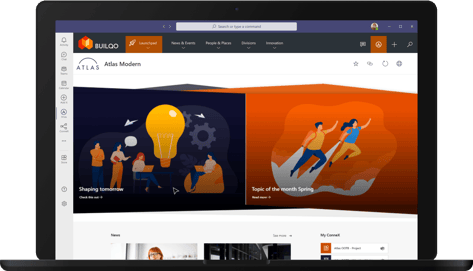Petula Aardenburg, Digital Marketing Manager
More blogs by this author
Petula Aardenburg, Digital Marketing Manager
More blogs by this authorThe latest research trends indicate that the majority of people prefer to keep working remotely (research YouGov survey and CIPD research). Other research indicates that some people find their work-life balance in splitting their time between working from home and in the office.
One thing is clear: hybrid working and hybrid workplaces are here to stay.
When you have your workforce split between the office and remote working, new challenges arise. What are the hybrid workplace challenges and what can you do to make the hybrid workplace a success?
Hybrid workplace challenge 1: Keeping productivity up
Hybrid workplace challenge 2: Employee engagement
Hybrid workplace challenge 3: The onboarding challenge
Hybrid workplace challenge 4: Slowing innovation

When working in a traditional office set up, productivity has always been a challenge, but even more so when your employees are working remotely. According to a report by Boston Consulting Group, 24% of managers feel it’s harder to control and drive productivity while remote. Collaborating with your co-workers may also be more challenging in a hybrid workplace. The study suggests that there are four factors which are key in driving productivity in collaborative tasks:
Technology is essential. According to the BCG study, managers and employees say they often feel they are not equipped to do remote working; they don’t have the tools, they need.
Choosing the right technology is essential to make your hybrid workplace a success. This will reduce the hybrid workplace challenges and enables staff to do their best work. A digital workplace like Atlas will help your hybrid workforce to easily communicate, collaborate and share knowledge, all in one place. A user-friendly interface that allows everyone to do their best work.
While remote working can certainly help with maintaining a healthy work-life balance, some employees still struggle with it. The “always on mode” and the feeling of being less productive can result in working longer hours.
One of the latest technologies designed to support hybrid working patterns is Microsoft Viva. This technology gives you insight on the balance between productivity and wellbeing. It helps you plan in regular breaks, focus work, learn and more. Managers and leaders also have privacy-protected insight in how their team is doing such as work patterns that can lead to burnout and stress.
Another hybrid workplace challenge is employee engagement. The research performed by BCG says that 39% of managers believe it is harder to ensure team engagement and connection.
Casual interactions are a natural way for humans to connect, especially when in an office environment. Whether it’s grabbing a coffee in the kitchen first thing, or throwing around concepts over the office water cooler, some of the most creative, profitable business ideas have come from these interactions.
Increased communication, improved transparency and having the right technology in place to do so, are key.
Digital tools are a great way to continue an increased level of transparency, combined with face-to-face communication. Weekly catchups with employees regarding their professional and personal lives can help to increase sincerity and encouragement.
Continue to leverage written communication in an asynchronous way, saving a day of back and forth via email or reduce a 90-minute meeting to 15.
As the way colleagues interact has changed, it’s these ‘water cooler moments’ which have become difficult to recreate and replicate. Despite this, it is possible to ensure they still occur online. Read more in our blog on how to recreate water cooler moments online.
With technology as the powerhouse, teams are given the tools to encourage and measure employee engagement. By harnessing technology, you can take a strategic approach to enhancing the employee experience. Atlas is a proven platform for enabling organisations to achieve ambitious plans while providing a sound structure for forward thinking ways of working.

Based on the BCG report, 51% of employees believe remote working makes it harder to maintain work culture, especially onboarding.
Most organisations have an onboarding process in place to ensure that new employees are settling in well in the organisation. With remote working, this of course comes with some challenges.
Atlas makes onboarding of new starters simpler and more engaging with self-service tools, collaborative learning and knowledge sharing. Employees can start onboarding right away with little effort using Atlas. Atlas provides new employees one place to get started, connects new employees to people and culture and much more.
Maintaining the work culture is essential. If you have some employees working in the office and others doing remote working, you need to make sure that nobody feels left out. Inclusivity is a key part here. Make sure that all team members are up to date on specific project updates, including those that have been discussed while making a coffee in the office.
The past year has put a much-needed spotlight on inclusion and diversity. We expect HR teams to put a greater focus on this. Our clients who are at the forefront creating modern and forward-thinking workplaces are using Atlas to centralise communication, engagement and support the change process.
The model for success is based on 3 simple yet powerful strands: Inform, Perform, Grow. Read more on How to Successfully Support you Diversity & Inclusion (D&I) Communication Strategy.
30% of remote managers believe they are innovating, down from 40% of managers in 2019, according to the BCG report.
Hybrid working offers the opportunity for staff to work together again face-to-face especially when it comes to brainstorming and ideation sessions. Organisations should re-imagine the role of the workplace as a drop-in place for collaboration and connection instead of a traditional desk-based office.
However, effective innovation when working in a hybrid workplace may see some challenges as well. For example, some colleagues may not be able to come into the office for planned brainstorming sessions. Finding the right digital tools and alternative approaches will therefore be important.
Instead of viewing innovation as challenge due to hybrid working, there is the broader opportunity for businesses to innovate and re-imagine business processes and strategies.
One approach is to encourage employees to be digitally dexterous with the right type of upskilling and encouragement from a digital-ready leadership.
Instead of relying on overburdened IT departments or outsourcing solutions, employees can be encouraged to self-serve or build their own solutions. Atlas is built with that specific purpose in mind and together with PowerApps, no-code has been an important disruptor, empowering business users to automate their processes and build perfect solutions to problems they understand best.
In summary, at the heart of the hybrid workplace are your people. Giving your employees the right skills, tools, and culture can empower your people to be more creative, more productive, and more collaborative.
Subscribe to our newsletter
This site is protected by reCAPTCHA and the Google Privacy Policy and Terms of Service apply.